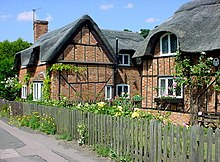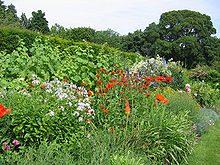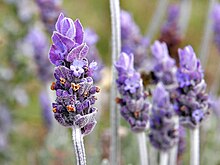Cottage garden
The cottage garden is a distinct style that uses informal design, traditional materials, dense plantings, and a mixture of ornamental and edible plants. English in origin, it depends on grace and charm rather than grandeur and formal structure. Homely and functional gardens connected to cottages go back centuries, but their stylized reinvention occurred in 1870s England, as a reaction to the more structured, rigorously maintained estate gardens with their formal designs and mass plantings of greenhouse annuals.
The earliest cottage gardens were more practical than today's, with emphasis on vegetables and herbs, fruit trees, perhaps a beehive, and even livestock. Flowers, used to fill spaces, gradually became more dominant. The traditional cottage garden was usually enclosed, perhaps with a rose-bowered gateway. Flowers common to early cottage gardens included traditional florists' flowers such as
Modern cottage gardens include countless regional and personal variations and embrace plant materials, such as ornamental grasses or
History
Origins

Cottage gardens, which emerged in Elizabethan times, appear to have originated as a local source for herbs and fruits.
Authentic gardens of the
Development
The "naturalness" of informal design began to be noticed and developed by the British leisured class.

William Robinson and Gertrude Jekyll helped to popularise less formal gardens in their many books and magazine articles. Robinson's The Wild Garden, published in 1870, contained in the first edition an essay on "The Garden of British Wild Flowers", which was eliminated from later editions.[9] In his The English Flower Garden, illustrated with cottage gardens from Somerset, Kent and Surrey, he remarked, "One lesson of these little gardens, that are so pretty, is that one can get good effects from simple materials."[10] From the 1890s his lifelong friend Jekyll applied cottage garden principles to more structured designs in even quite large country houses. Her Colour in the Flower Garden (1908) is still in print today.
Robinson and Jekyll were part of the
In the early 20th century the term "cottage garden" might be applied even to as large and sophisticated a garden as
The cottage garden in France is a development of the early 20th century.
Design
While the classic cottage garden is built around a
The cottage garden is designed to appear artless, rather than contrived or pretentious. Instead of artistic curves, or grand geometry, there is an artfully designed irregularity. Borders can go right up to the house, lawns are replaced with tufts of grass or flowers, and beds can be as wide as needed. Instead of the discipline of large scale color schemes, there is the simplicity of harmonious color combinations between neighbouring plants. The overall appearance can be of "a vegetable garden that has been taken over by flowers."[22] The method of planting closely packed plants was supposed to reduce the amount of weeding and watering required. But some features, such as planted stone paths, turf pathways, or clipped hedges overgrown with wayward vines, still need well-timed maintenance.
Materials
Paths, arbors, and fences use traditional or antique looking materials. Wooden fences and gates, paths covered with locally made bricks or stone, and arbors using natural materials all give a more casual—and less formal—look and feel to a cottage garden.[25] Pots, ornaments, and furniture also use natural looking materials with traditional finishes—everything is chosen to give the impression of an old-fashioned country garden.[23]
Plants
Overview
Until the late 19th century, cottage gardens mainly grew vegetables for household consumption. Typically half the garden would be used for cultivating
Modern cottage garden plants are typically flowers chosen for their old-fashioned and informal appeal. Many modern day gardeners use
Roses

Cottage gardens are always associated with roses: shrub roses, climbing roses, and old garden roses with lush foliage, in contrast to the gangly modern hybrid tea roses. Old cottage garden roses include cultivated forms of
The
With the introduction of China roses (derived from
Climbing plants

Many of the old roses had cultivars that grew very long canes, which could be tied to trellises or against walls. These older varieties are called "ramblers", rather than "climbers".
Hedging plants
In the traditional cottage garden, hedges served as fences on the perimeter to keep out marauding livestock and for privacy, along with other practical uses.
Flowers and herbs

Popular flowers in the traditional cottage garden included florist's flowers which were grown by enthusiasts—such as violets, pinks, and primroses
Today herbs are typically thought of as culinary plants, but in the traditional cottage garden they were considered to be any plant with household uses. Herbs were used for medicine, toiletries, and cleaning products. Scented herbs would be spread on the floor along with rushes to cover odors. Some herbs were used for dyeing fabrics.
Fruits
Fruit in the traditional cottage garden would have included an
See also
References
- ISBN 1-84340-216-5.
- ^ ]
- ^ Anne Scott-James, The Cottage Garden (London: Lane) 1981, de-mythologised the origins of the English cottage garden, and its treasured topiary among the vegetables and flowers, popularly supposed to represent heirlooms from the seventeenth century.
- ISBN 1-86962-049-6.
- ISBN 0-300-12508-9, p 659
- ISBN 978-0-7513-0702-3.
- The University of Chicago Press. p. 253.
- JSTOR 1586902.
- JSTOR 1586557. p. 63f.
- ^ Massingham, p. 71.
- ISBN 978-0-419-19300-5.
- ISBN 978-0-7112-2800-9.
- ISBN 978-0-7425-0399-1.
- ISBN 978-0-7112-1370-8.
- ISBN 978-1-56792-102-1.
- ^ a b Vita Sackville-West, "Hidcote Manor", Journal of the Royal Horticultural Society 74 (1949:476-81), as noted by Brent Elliott in "Historical Revivalism in the Twentieth Century: A Brief Introduction" Garden History 28.1, Reviewing the Twentieth-Century Landscape (Summer 2000:17–31)
- ^ The "old roses" Vita Sackville-West was rediscovering were introduced from French growers in the 1830s and 1840s. See Graham Stuart Thomas, The Old Shrub Roses.
- ISBN 978-0-88402-201-5.
- ^ ODNB entry for Margery Fish by Catherine Horwood Retrieved 1 December 2012. (Pay-walled)
- ISBN 978-1-56158-474-1.
- ^ "Designing the Country Cottage Garden". aggie-horticulture.tamu.edu. Archived from the original on 2011-07-13. Retrieved 2008-12-28.
- ^ ISBN 978-0-88192-690-3.
- ^ ISBN 978-0-7112-0812-4.
- ISBN 978-1-56158-474-1.
- ISBN 978-0-7513-0702-3.
- ^ "Directive Hints for the effective Cultivation of Cottage Gardens". Gardener's Magazine (December). J.C. LOUDON: 648. 1832.
- ^ "Cottage Cookery". The Farmer's Magazine. 27. Rogerson and Tuxford: 145. 1865.
- ^ a b c Scott-James, The Pleasure Garden, p. 83.
- ISBN 978-1-56158-474-1.
- ISBN 978-1-56158-474-1.
- ISBN 978-1-57061-363-0.
- ISBN 978-1-57061-363-0.
- ISBN 978-1-57061-363-0.
- ISBN 978-0-88192-644-6.
- ^ ISBN 978-1-84403-065-1.
- ISBN 978-1-84537-105-0.
- ISBN 978-0-7153-2196-6.
- ISBN 978-0-88192-698-9.
- ISBN 978-1-84403-065-1.
- ISBN 978-0-7112-2057-7.
- ISBN 978-0-88192-698-9.
- ^ The raw fruits, considered indigestible, were not much eaten before the twentieth century.
- ISBN 978-1-84403-065-1.
- Bibliography
- Clayton, Virginia Tuttle (2000). The Once and Future Gardener: Garden Writing from the Golden Age of Magazines, 1900–1940. David R. Godine Publisher. ISBN 978-1-56792-102-1.
- Garland, Sarah (2003). The Herb Garden. Frances Lincoln Publishers. ISBN 978-0-7112-2057-7.
- Gould, Jim (Spring 1988). "The Lichfield Florists". Garden History. 16 (1). Garden History, Vol. 16, No. 1: 17–23. JSTOR 1586902.
- Horwood, Catherine (2008). Potted History: The Story of Plants in the Home. Frances Lincoln Publishers. ISBN 978-0-7112-2800-9.
- Hunt, John Dixon; Joachim Wolschke-Bulmahn (1993). The Vernacular Garden: Dumbarton Oaks Colloquium on the History of Landscape Architecture XIV. Dumbarton Oaks. p. 9. ISBN 978-0-88402-201-5.
- Kammen, Carol; Norma Prendergast (2000). Encyclopedia of Local History. Rowman Altamira. ISBN 978-0-7425-0399-1.
- Kendle, Tony; Stephen Forbes (1997). Urban Nature Conservation: Landscape Management in the Urban Countryside. Taylor & Francis. ISBN 978-0-419-19300-5.
- Lloyd, Christopher; Richard Bird (1999). The Cottage Garden. Jacqui Hurst. Dorling Kindersley. ISBN 978-0-7513-0702-3.
- Massingham, Betty (1978). "William Robinson: A Portrait". Garden History. 6 (1). The Garden History Society: 61–85. JSTOR 1586557.
- Reynolds, Myra (1896). The Treatment of Nature in English Poetry Between Pope and Wordsworth. The University of Chicago press.
- Sackville-West, "Hidcote Manor", Journal of the Royal Horticultural Society 74 (1949:476-81), noted by Brent Elliott, "Historical Revivalism in the Twentieth Century: A Brief Introduction" Garden History 28.1, Reviewing the 20th-century Landscape (Summer 2000:17–31)
- Schulman, Andrew; Jacqueline Koch (2004). The Northwest Cottage Garden. Sasquatch Books. ISBN 978-1-57061-363-0.
- Scott-James, Anne (1981). The Cottage Garden. Allen Lane. ISBN 978-0-7139-1263-0.
- Scott-James, Anne; Osbert Lancaster (2004). The Pleasure Garden: An Illustrated History of British Gardening. Frances Lincoln Publishers. ISBN 978-0-7112-2360-8.
- White, Lee Anne (2001). Exploring Garden Style: Creative Ideas from America's Best Gardeners. Taunton Press. ISBN 978-1-56158-474-1.
External links
- Royal Horticultural Society British gardening charity
- The Cottage Garden Society British Gardening society
